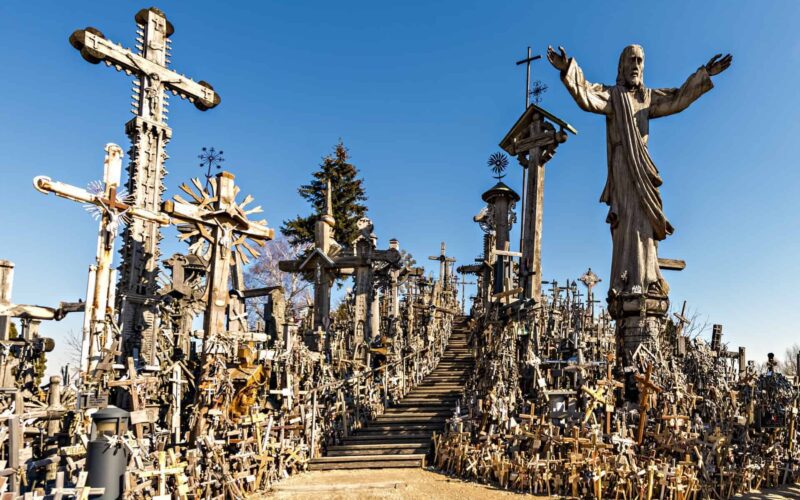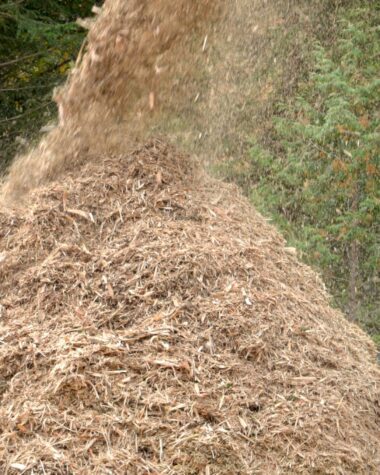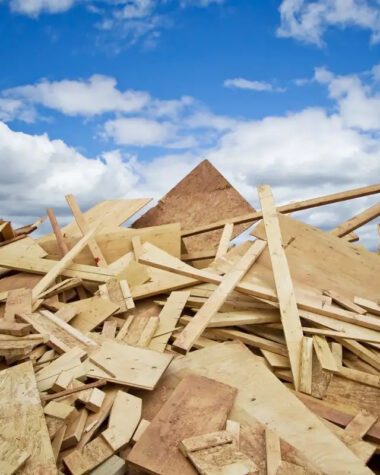Since the 15th century, Lithuanians have erected crosses to pay respect to the dead and the spirits. They do it in hopes of gaining their favor, as a mark of appreciation, and in pursuit of safety and enlightenment. Also, these monuments reflect the Lithuanian’s respect for the environment and religion. Interestingly, historians believe that the tradition of crafting pillar shrines out of wood is rooted in the pre-Christian period of the country.
Did You Know?
When Lithuanians say that a man is as strong as Stelmužė oak, it means symbolism of strength and statehood much like the Stelmužė oak. It is the oldest tree in Europe, with an age of between 1000 and 1500 or possibly 2000 years. Due to this, the place where it dwells has been called by the tree’s name and is considered a natural landmark in Lithuania.
This type of oak measures 23 m in height, 3.5 m in circumference, and 13 m in girth. Because it has withstood the test of time, the place is considered historical. The place has witnessed a lot of life for the past centuries, including Kaiser and Hitler armies.
Additionally, Swedish armies, Crusaders, Knights of the Sword, and Lithuanian dukes have been here. The discovery of a human skeleton and a French gun in the hollow shows that one of Napoleon’s soldiers may have used this tree as cover while traveling from Russia.
Who Are The Lithuanians?
Lithuanians are the inhabitants of Lithuania. This country was first mentioned in 1009, more than a thousand years ago. Lithuania is the largest of the three Baltic States: Poland, Belarus, and Latvia, despite its very modest size. In its early years, the country was one of the biggest and most powerful nations on the European continent.
Lithuania was officially formed as a country in the middle of the 13th century, although the earliest mention of the Baltic country dates back to the 11th century. Lithuania reached one of its most prosperous periods in the middle ages of the 15th century.
In 1569, the country entered a union with Poland, forming the Polish Lithuanian Commonwealth, also known as the “Republic of the Two Nations.” In the 18th century, Lithuania became a part of the Russian Empire.
Moreover, it was a place where overseas trades and crafts prospered. However, it was not only the times of glory that marked the country’s history. Instead, there were centuries of darkness and despair. But deep within the hearts and minds of the Lithuanian people, their collective consciousness was kept alive.
Thus, century after century, the people were patiently walking towards regaining their freedom, and as we are about to find out in this article, cross-crafting has been one of the secret weapons that saved the Lithuanian nation’s collective psyche from destruction and oblivion.
Fighting for Independence: Lithuanian Traditional Cross-Crafting
The term “cross-crafting” describes a well-known custom of creating altars and crosses and the consecration of those crosses and the attendant rites. The carved oak crosses are related to religious events and Catholic rituals. The cross gains an unchangeable religious value after being consecrated by a priest.
Cross-crafting is not taught in any schools today, as it was in the past; instead, it is passed down through non-formal education. Cross-crafting is seriously threatened by rural flight and the homogenization that results from media impact. Although the parishes are responsible for maintaining the crosses, further assistance is required.
From 1940- 1990, Lithuanians were subjected to severe religious restrictions. In fact, building crosses was strictly prohibited by the country’s occupants. The most ironic aspect of the restrictions on religion is that Lithuania was the last of the other European nations to convert from pagan religion to Catholicism.
The said transition of religion happened in the 14th century. However, the pagan ideas are firmly ingrained and closely linked to the inhabitants’ official religion, where the Roman Catholic Church’s doctrines predominate over those of the Lutheran Catholic Church.
Raising their silenced voice throughout the reign of the Soviet Union Regimen when religion was banned, Lithuanians began erecting crosses tenaciously all across the country. At the beginning of the 20th century, one of the most amazing places in the world was born in Lithuania – the Hills of Crosses near Šiauliai.
The Hill of Crosses and the Persistence of the Lithuanian
The tradition has played a significant role in Lithuanian cross-crafting, making the cross a way to express appreciation and implore mercy and forgiveness. However, the time came when the Lithuanians’ holy practices were tested because they were under Russian occupation. The Tsarist Russian authorities outlawed the erection of crosses shortly after a failed insurrection by Lithuanians in 1863.
Despite the political danger, each time the Russian authorities burned down the Hill of Crosses, the natives would rebuild the site. It highlights the thirst for independence of the Lithuanian nation. It wasn’t before September 6, 1991, that Lithuania finally received official recognition for its independence from the Soviet Union since the first independence proclamation from 1990 was not recognized.
UNESCO and Lithuanian Unbreakable Determination
In 2001, UNESCO recognized the outstanding importance of carved crosses from a historical, cultural, artistic, and ethnological point of view by designating the Lithuanian cross-crafting technique as a “Masterpiece of the Oral and Intangible Heritage of Humanity” (UNESCO: 2001).
However, church crosses are not a part of the inscribed art. Instead, it describes crosses and shrines made of oak wood that are typically one to five meters high and sometimes include iron. Lithuania is home to many crosses, which can be found in a variety of locations, including graveyards, village entrances, cemeteries, roads, woodlands, and riverbanks.
Wooden Heritage in Lithuania
One of the most significant parts of Lithuanian culture is the wooden cultural heritage pieces that constitute an essential component of Lithuanian architectural legacy. Most of the structures built in Lithuania before 1940 are made of wood. However, they were degraded during the 20th century.
Meanwhile, the Soviets detested wooden structures so much that after occupying Lithuania, they prohibited images of wooden structures in urban settings. The fact that some of these buildings have intricate architectural aspects may make them particularly attractive to someone from the west, where wood is only sometimes utilized in construction.
The Žvėrynas borough of Vilnius is home to many lovely wooden houses. Žvėrynas became a wealthy area in the 1990s, and numerous new structures were built there after 1990, somewhat changing the district’s appearance. However, the Šnipiškės borough of Vilnius is still a complete and authentic representation of a timber suburb from the 19th century, down to some unpaved streets.
In Kaunas, the Žaliakalnis borough is home to numerous wooden structures. The open-air museum in Rumšiškės, where numerous old village structures were transported from around Lithuania, is a must-see for anybody who likes wooden architecture.
Another incredibly fascinating and unusual sight is the few wooden synagogues and mosques that survived Soviet captivity. The wooden villas in resort towns like Palanga, Druskininkai, or Juodkrantė (Neringa), as well as the wooden manors that dot the countryside, are renowned for their beauty (their rich owners did not attempt to save money on exterior details).
Final Thoughts
Amidst the conflicts Lithuanian faced in the early times, their determination remained their driving force to do what they wanted. They needed to express their belief by raising crosses made of wood. It is a significant action because the wood has been part of their determined culture. As a result, UNESCO saw that they deserved recognition.
Instead, it is a living evidence in Lithuanian history that points to their imperishable Faith, spiritual strength, and Hope. For more inspiration from various cultures, do not hesitate to visit our wood fact section.








